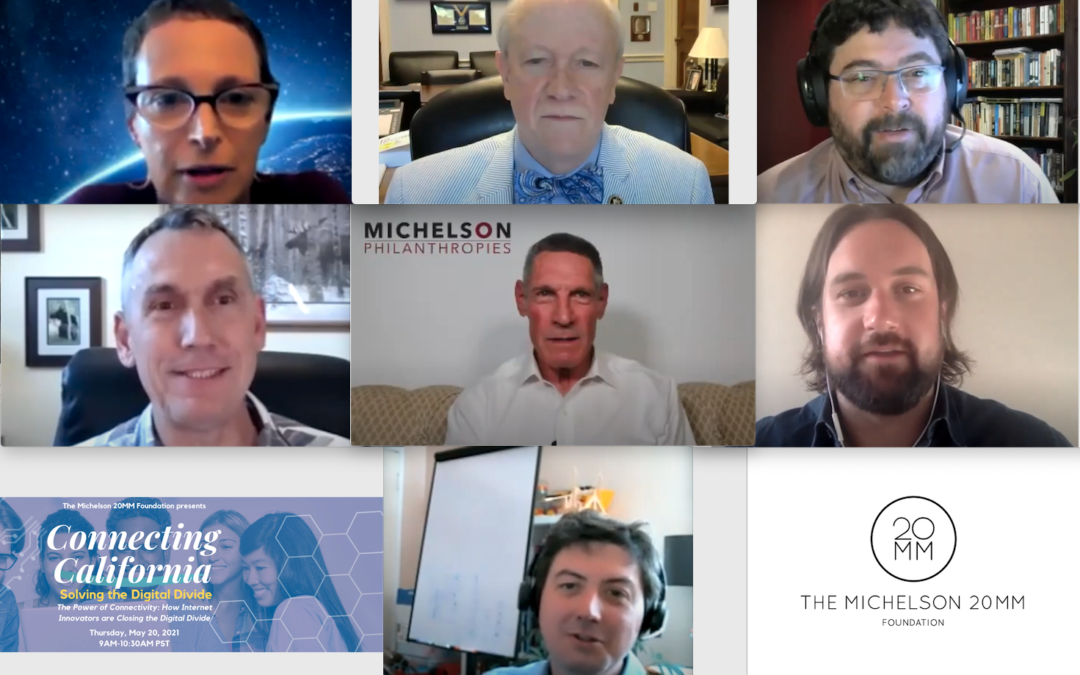On May 20th, the Michelson 20MM Foundation hosted The Power of Connectivity: How Internet Innovators are Closing the Digital Divide, a virtual event that saw experts on internet connectivity and champions for social equity discuss methods for ensuring students, educators, and families enjoy access to reliable, high-speed internet.
The Current System Is Broken
Michelson 20MM Founder and Co-Chair Gary K. Michelson, M.D., set the stage by reminding us that “we cannot look to our incumbent internet service providers (ISPs) to bridge the digital divide that they helped create.” According to the FCC, there are more than 19 million unconnected Americans who lack access to critical educational, workforce, and medical resources found online. This includes more than a quarter of those living in rural communities and 2% of city dwellers. In response to and in defiance of the monopolies established by major ISPs, innovative connectivity solutions such as municipal broadband networks and cooperatives have emerged as viable alternatives for bringing the internet to underserved populations. To eliminate the digital divide, community coalitions across the country are developing their own solutions for providing internet access or partnering with independent service providers that place people ahead of profits.
Innovative Approaches are Promising but Face Obstacles
When it comes to connecting the unconnected, Joanne Hovis, broadband advocate and President of CTC Technology & Energy, confirms that “new models are emerging including new innovation around various kinds of public-private collaboration.” One such effort is the Fiber to Housing Partnership described by Preston Rhea. His company, MonkeyBrains, is an independent ISP that works with the local government to deliver internet to affordable housing units throughout San Francisco. Currently, 7,000 units across more than 50 affordable housing sites in the Bay Area receive high-speed, low-cost internet through MonkeyBrains’ Fiber to Housing network. But for this model to continue to succeed, networks must remain open access. “Open access allows for competition and lowers costs. It helps spur innovation, which has always spurred the American economy,” says Seth Hoedl, co-founder of the Post Road Foundation.
Public infrastructure is helping in linking unconnected Americans to the internet. Ammon, Idaho, population 16,500, has the most sophisticated fiber network in the country thanks to a public-private model and the work of the town’s technology director Bruce Patterson. However, Patterson notes that going up against major ISPs isn’t easy considering that “there is a very successful effort to maintain monopolies” and “resistance to rate control…and resistance to competition.” He adds that “municipalities have the will to build these models, are willing to pay for it, but find that they ultimately don’t have the authority to do so given the current policy landscape.” This policy landscape is a result of unopposed and incredibly well-financed lobbying efforts coordinated by major ISPs that are doing everything they can to impede further competition and to maintain their strangleholds on the market. As a consequence of ISP lobbying efforts, over 20 states have enacted anti-municipal broadband laws, preventing, impeding, or discouraging the development of publicly-owned internet networks.
We Must Look Beyond Short-Term Fixes
During the live stream, Dr. Michelson implored us to look beyond the short-term fix of subsidies that only reward the bad behavior of ISPs. The words weren’t lost on Congressman Jerry McNerney (CA-09), who emphasized the importance of policy solutions currently active in Washington, D.C., and the urgent need to address the digital divide challenges. In closing, Chris Mitchell, director of the Community Broadband Networks initiative at the Institute for Local Self Reliance, pointed out that philanthropy plays a critical role in helping everyone stay away from the short-term fixes policymakers customarily fall back on. “Every county should have a digital equity plan and philanthropy can play a huge role in getting that planning started,” Mitchell says.
If you missed our Connecting California events, you can find the recordings on our YouTube playlist.

